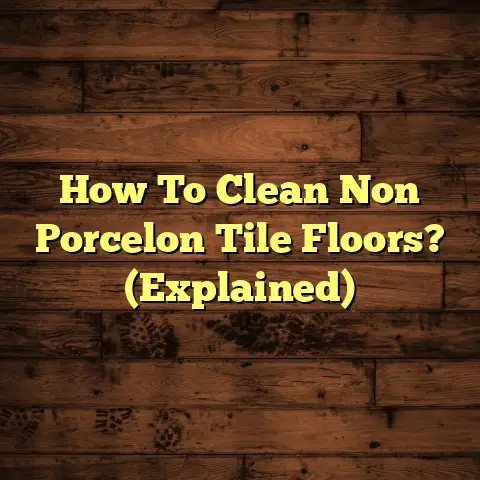Remove Nail Polish From Wood? (4 Stain Removal Tips!)
Don’t worry, though! It happens to the best of us. And the good news is, it’s often fixable.
In this article, I’m going to share my top four stain removal techniques for banishing nail polish from wood. We’ll also cover prevention tips and post-cleanup care. Let’s dive in!
Section 1: Understanding the Nature of Nail Polish and Its Impact on Wood
1.1 Composition of Nail Polish
Ever wonder what’s actually in that bottle of vibrant color? Nail polish is a complex mix of chemicals, including:
-
Solvents: These are the liquids that dissolve the other ingredients, allowing the polish to be applied smoothly. Common solvents include ethyl acetate and butyl acetate.
-
Pigments: These provide the color. They can be organic or inorganic compounds.
-
Resins: These help the polish adhere to the nail and form a film. Nitrocellulose is a common resin.
-
Plasticizers: These add flexibility and prevent the polish from cracking.
-
Film Formers: These help in creating a smooth and even layer of color over your nails.
When nail polish spills on wood, the solvents can interact with the wood finish, potentially softening or even dissolving it. The pigments can then seep into the wood pores, causing a stain.
1.2 Types of Wood Finishes
Not all wood finishes are created equal. Some are more vulnerable to nail polish spills than others. Here’s a quick rundown:
-
Polyurethane: This is a durable, plastic-like finish that’s resistant to many chemicals. It’s a common choice for floors and furniture.
-
Lacquer: This finish dries quickly and provides a smooth, glossy surface. It’s often used on furniture, but it’s more susceptible to damage from solvents than polyurethane.
-
Varnish: Similar to lacquer, varnish provides a protective coating. It’s available in various sheens, from matte to glossy.
-
Oil-Based Finishes: These finishes penetrate the wood, enhancing its natural beauty. They’re less resistant to spills than polyurethane or lacquer.
-
Wax Finishes: Wax provides a natural, low-sheen finish. However, it offers minimal protection against spills and stains.
Why is identifying the finish important?
Because the type of finish will determine which removal method is safest and most effective. For instance, you’d want to be more cautious with lacquer or varnish than with a tough polyurethane finish.
Section 2: Preparation Before Stain Removal
2.1 Gathering Necessary Supplies
Before you start attacking that nail polish stain, gather your tools. Here’s what I recommend having on hand:
-
Cotton Balls/Swabs: For applying and blotting solutions.
-
Rubbing Alcohol (Isopropyl Alcohol): A good first attempt for many finishes.
-
Acetone-Free Nail Polish Remover: Gentler than pure acetone, but still effective.
-
Soft Cloths (Microfiber Preferred): For wiping and buffing.
-
Wood Polish: To restore the shine after cleaning.
-
Clean Water: To rinse the area.
-
Mild Dish Soap: For gentle cleaning.
-
Eye Dropper: For precise application of cleaning solutions.
-
Old Toothbrush: For scrubbing textured surfaces.
-
Protective Gloves: To protect your hands from chemicals.
Eco-Friendly Alternatives:
If you’re concerned about using harsh chemicals, consider these alternatives:
-
Vinegar and Olive Oil Mixture: A natural cleaning solution.
-
Baking Soda Paste: For gentle abrasion.
2.2 Testing on an Inconspicuous Area
This is crucial. Before you apply any cleaning solution to the stain, test it on a hidden spot. This could be the underside of a table, the inside of a cabinet, or an area hidden by furniture.
Here’s how to conduct a test patch:
-
Apply a small amount of your chosen cleaner to a cotton ball.
-
Gently rub the cleaner on the test area.
-
Wait a few minutes and observe the area.
-
Check for any discoloration, damage to the finish, or changes in the wood texture.
If the test area looks fine, you can proceed with the stain removal. If not, try a different method.
Section 3: Four Effective Stain Removal Techniques
Okay, let’s get down to business! Here are four techniques I’ve used successfully to remove nail polish from wood:
3.1 Technique 1: Rubbing Alcohol
Rubbing alcohol is often my first line of defense because it’s relatively gentle and readily available.
Here’s how to use it:
-
Dampen a cotton ball with rubbing alcohol.
-
Gently blot the nail polish stain, working from the outside in.
-
Avoid rubbing vigorously, as this can spread the stain.
-
Continue blotting until the nail polish begins to lift.
-
Use a clean cloth to wipe away any residue.
-
If the stain persists, repeat the process.
Pros:
- Readily available.
- Relatively gentle on most finishes.
- Inexpensive.
Cons:
- May not be effective on all types of nail polish or wood finishes.
- Can dry out the wood if used excessively.
Tips for Protecting the Wood Finish:
- Use rubbing alcohol sparingly.
- Avoid prolonged contact with the wood.
- Apply wood polish after cleaning to restore moisture and shine.
3.2 Technique 2: Acetone-Free Nail Polish Remover
Acetone-free nail polish remover is a step up in strength from rubbing alcohol, but it’s still gentler than pure acetone.
Why Acetone-Free?
Acetone can be too harsh for some wood finishes, potentially dissolving or damaging them. Acetone-free removers use alternative solvents that are less aggressive.
Here’s how to use it:
-
Dampen a cotton ball with acetone-free nail polish remover.
-
Gently blot the nail polish stain.
-
Let the remover sit on the stain for a few seconds to soften it.
-
Wipe away the softened nail polish with a clean cloth.
-
Repeat as needed.
-
Clean the area with a damp cloth and mild soap.
-
Dry thoroughly.
Enhancing the Wood’s Appearance Post-Removal:
After cleaning, apply a coat of wood polish or furniture wax to restore the wood’s shine and protect it from future stains.
3.3 Technique 3: Vinegar and Olive Oil Mixture
For a natural approach, try a mixture of vinegar and olive oil. This combination can help loosen the nail polish and moisturize the wood.
How to Create and Apply the Mixture:
-
Mix equal parts white vinegar and olive oil (e.g., 1 tablespoon of each).
-
Apply the mixture to the nail polish stain with a cotton ball or cloth.
-
Let it sit for 5-10 minutes to penetrate the stain.
-
Gently rub the area with a soft cloth.
-
Wipe away any residue with a clean, damp cloth.
-
Dry the area thoroughly.
Benefits of Using Natural Products:
- Gentle on wood finishes.
- Non-toxic and environmentally friendly.
- Can help moisturize the wood.
3.4 Technique 4: Commercial Wood Cleaners
If the previous methods don’t work, you can try a commercial wood cleaner specifically designed to remove tough stains.
Criteria for Selecting the Right Product:
- Read the label carefully: Make sure the product is safe for your specific type of wood finish.
- Look for products that are specifically designed for stain removal: These products often contain stronger solvents and cleaning agents.
- Check customer reviews: See what other users have to say about the product’s effectiveness.
How to Properly Apply It:
- Follow the manufacturer’s instructions carefully.
- Apply the cleaner to a clean cloth, not directly to the wood.
- Gently rub the affected area.
- Wipe away any residue with a clean, damp cloth.
- Dry thoroughly.
Following Manufacturer Instructions:
This is crucial! Different products have different application methods and safety precautions. Always read and follow the instructions on the label.
Section 4: Post-Removal Care for Wood Surfaces
4.1 Cleaning the Area Thoroughly
After removing the nail polish, it’s important to clean the area to remove any remaining residue.
Recommended Cleaning Solutions and Methods:
- Mild Soap and Water: A gentle solution for most wood finishes.
- Wood Cleaner: Use a wood cleaner specifically designed for your type of finish.
How to Clean:
-
Dampen a clean cloth with your chosen cleaning solution.
-
Wipe the affected area gently.
-
Rinse with a clean, damp cloth.
-
Dry thoroughly.
4.2 Restoring the Wood Finish
Nail polish removal can sometimes leave the wood looking dull or dry. To restore its original shine and protection, apply a coat of wood polish or sealant.
Tips for Reapplying Wood Polish or Sealant:
- Choose the right product: Select a polish or sealant that is compatible with your wood finish.
- Apply a thin, even coat: Avoid applying too much product, as this can leave a sticky residue.
- Buff the surface: Use a clean, soft cloth to buff the surface to a shine.
Maintenance Routines to Keep Wood Surfaces Looking Pristine:
- Dust regularly: Use a soft cloth or duster to remove dust and debris.
- Clean spills immediately: Wipe up spills as soon as they occur to prevent staining.
- Apply wood polish or sealant periodically: This will help protect the wood and keep it looking its best.
Section 5: Preventive Measures for Future Nail Polish Mishaps
Prevention is always better than cure! Here are some tips to minimize the risk of future nail polish spills:
5.1 Creating a Safe Nail Painting Space
Designate a specific area for nail care to minimize the risk of spills.
Suggestions for Setting Up a Designated Area:
- Choose a well-ventilated area: This will help prevent the buildup of fumes.
- Use a protective covering: Cover your work surface with a tablecloth, newspaper, or plastic sheet.
- Keep supplies organized: Store your nail polish, remover, and other supplies in a designated container.
Importance of Using Protective Coverings on Surfaces:
Protective coverings can prevent nail polish from coming into contact with your wood furniture or floors.
5.2 Educating Family Members on Nail Care
Discuss nail care practices within the household to prevent accidents.
Tips for Discussing Nail Care Practices:
- Emphasize the importance of being careful when applying nail polish.
- Encourage family members to use protective coverings when painting their nails.
- Remind everyone to clean up spills immediately.
Encouraging Responsible Usage of Nail Products Around Wooden Surfaces:
By promoting responsible usage, you can help prevent nail polish spills and keep your wood surfaces looking their best.
Conclusion: Embracing Seasonal Beauty Without Worry
So there you have it! Four effective techniques for removing nail polish from wood, along with tips for post-removal care and prevention.
With a little patience and the right tools, you can tackle those accidental spills and keep your wood surfaces looking beautiful. Now go ahead, embrace the season, and enjoy your favorite nail polish colors without the worry of permanent stains!





